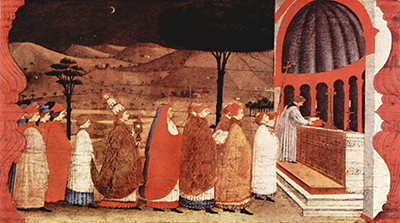Commissioned by a brotherhood of laymen called the Confraternity of the Corpus Domini between 1467 and 1469, this is the third in a six-panel tempera which can now be found in the Galleria Nazionale delle Marche in Urbino.
This scene depicts a procession to reconsecrate the host after it was sold to a Jew who tried to burn it in the previous scene. The whole six panels were lost for over a hundred years before being rediscovered in a barn in the mid-nineteenth century and restored to their current glory.
Scene three shows Uccello's further exploration with three-dimensional space and linear perspective as the procession of characters in the fore are carefully placed against the mathematical perfection of the straight lines of the altar and the subtle formations of the hills beyond. His use of clear and dramatic colours adds a further sense of dimension as the rich, dramatic brush strokes of the outfits in the foreground and the burnished orange pillar create a stark contrast to the darker shades of sand and night-time sky in the background.
The moon with its clarity and brightness against the shadowy sky gives a further feeling of depth as the eye is drawn away from the vibrant villagers to the plains reaching out to a horizon that feels far away. The black trees in the middle distance also manage to exert a power of their own both in accentuating a contrast with the brightness of the altar and adding a sense of height as they extend to the cloudy sky.
Against the variety of sombre shades that create depth in the middle distance and foreground, the altar seems almost translucent in its own brightness as the purity of the white brush strokes convey a feeling of holy power as the host is once more consecrated and approved by God. Similarly, the ravishing orange and shining whites of the clothing of the characters in the procession adds a luminous essence as if the deeds of these characters seem to shine out against the darker heathen backdrop.
This scene clearly depicts the tapestry style Uccello employs in the rest of the panels as well as in some of his other works. The characters here are slightly more lifelike than in some of his other works, but the crystalline effect of his experiment with light adds the magical, fairy tale quality that defines much of his style overall.




